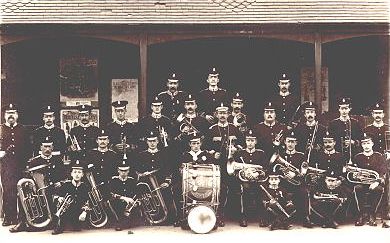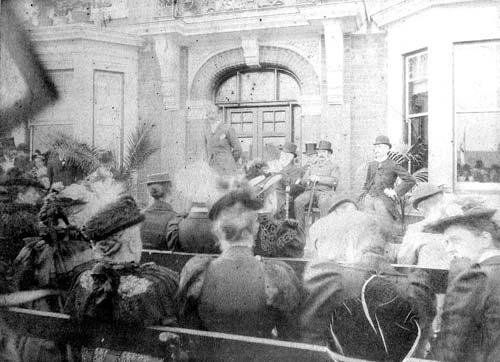Although Reginald Stanley was heavily involved in setting up this great building, he wasn't the brains behind the idea. Some 16 years before this building was opened, Dr Richard Bird Nason was conjuring up an idea to give Nuneaton a Cottage Hospital. Cottage Hospital's were set up for rural area's giving patients local care and to stop unnecessarily long and possibly painful journey's. All his life had been devoted to his profession as a medical practitioner, and dealing with people in the poor neighbourhoods of Nuneaton made him realise that a hospital was needed. Twice Dr Nason tried to get the hospital fund going but couldn't get the backing from enough people to get it up and running.

Dr Edward Nason Esq one of the major forces behind the Hospital
Around 1890 Dr Nason's son Edward (also a medical practitioner) became involved and wasn't going to fail his father's idea. He gathered together some of biggest names in the town and sold the idea of a Nurses Institute. Mr Joseph Fielding Johnson, Dr Richard Bird Nason, Mr Reginald Stanley and Canon Bellairs all sat on the committee and Edward was Hon Secretary. In the first twelve months it was a great success and instead of just sticking with the Nurses Institute, the committee decided that a cottage hospital was needed.
I'm guessing that Reginald, using his contacts, got Mr James Tomkinson (Lord of the Manor) involved in the project and they came forward with a plot of land on which the hospital could be built. They still needed £3500 to build and furnish the establishment, so various money raising events took place across the local area.
Below is a passage from the Nuneaton Observer on the 22nd September 1893.
"A Fashionable concert at Atherstone"
The concert given at Nuneaton last week, in aid of the funds of the cottage hospital, was repeated at the Corn Exchange, Atherstone, on Tuesday evening before a very appreciative audience. The promoters had again to deplore a lack of patronage at the back of the Hall, which is a fact to be the more regretted because it is the working classes who will mainly benefit by the Institution in question. A great deal of time and trouble had been expended on the platform decorations by Miss Miles, Miss Loudon, Mr B Miles and Mr T Wilson who brought ferns, plants and drawing-room accessories into a most tasteful harmony, The arrangement reflecting the highest credit upon all who had kindly rendered assistance in this direction. We also noticed the acoustic properties of the building enabled the performers to be heard to far greater advantage than was the case last week. There was only one alteration in the list of artistes Miss Jenny Main, the lady reciter, giving place to that great local favorite Mrs Henry Stubbs of Camp Hill Hall. The poem selected by this talented lady in the first part of the entertainment was "the false lights of Rosilly" and the amount of fire and dramatic earnestness thrown into the recital had a very powerful effect upon the audience. Her second effort, the title of which did not transpire, consisted of a monlogue (in character) describing the woes of a garrulous old washer woman blessed with an elderly unmarried daughter, Matilda Jane, who believed in courting at all costs. How this unfortunate weakness for the male sex led her to appropriate the husband of a "respectable" greengrocers ending in a dis-agreeable complications , was told by Mrs Stubbs in her inimitably droll style. For an encore she gave " The Two Kittens". We have little to add to our comments upon the various performances of last week. The inevitable encores gained by Miss Kate Wilson revealed more clearly than ever what a marvellously facille mastery this young lady possesses over the instrument to which she is still wooing so assiduously at the Royal Academy of Music. Mr W. Hill gained encores for both his songs and Mrs Mason, Miss Cooper and Mr Tom White were all accorded a similar mark of appreciation in Part 2. Miss Ball was heard to advantage in the two vocal duets, and Dr Tomlinson's performances on the violoncello were accompanied with all the musical fidelity which we have long associated with the name of this finished player. Miss Swinnerton again undertook the whole of the accompaniments with her characteristic kindness.

A picture of The Cottage Hospital in the early 1900's. courtesy of Nuneaton Library

Finally, work could begin on building a hospital that Nuneaton could be proud of. Reginald Stanley brought in Mr Frederick John Yates of Birmingham, an architect, to draw up the plans. He then had built a short road leading up to the hospital with trees and a perimeter fence, all at his own expense. The building of the hospital was left to another of Stanley's close associates, Mr Thomas Smith, a builder and quarry owner from Chilvers Coton.
A description of the hospital was given in the Nuneaton Observer stating that the building had two wards either side of the main administration block, each with eight beds and at the end was the nurses room with a large inspection window. At a suitable distance toward the back of the grounds was the mortuary. At the front was a well lit day room and matrons office with commanding views of the gardens. Upstairs were five nurses bedrooms with bathroom and facilities.
The outside of the building was also built to a high standard using various bricks, tiles, finials and terracotta ornamental decor from Stanley's very own brickwork's.

One of Nuneaton Cottage Hospital's wings the decor of the outside used some of Stanley's ornimented pattern from his brickyard more than likely designed by Jacob Stanley.

The Cottage Hopsital opening ceremony promoted in the Nuneaton Observer.
At 3.00pm on the 21st September 1893 all of Nuneaton's big names came to see a town-changing moment. Guests included Mrs Newdigate (Arbury), Mrs Dugdale (Merevale), Messrs J.F Johnson, C.A Phillips, E.F Melly, R Ramsden and most of the clergy and medical men of the neighbourhood. The Nuneaton Excelsior Band lead by Mr Richard Train kept the crowds entertained until the formal openings started.
First to address the large crowd was Dr E Nason. He advised everyone that the hospital was opening debt free (cheers came up) and then gave Rt Hon J.Tomkinson and Mr R.Stanley a special thanks for donating the land. Mr Tomkinson then stepped up. He gave a short speech saying that the hospital is proof of Nuneaton's growing industrial stature. Unfortunately the opening didn't go so smoothly as the "silver key" to officially open the hospital had been made to the wrong size and had to be sent back to the maker and this hadn't made it back in time. But the show must go on as they say..... the doors opened and everyone was invited in for tea and refreshments, and a donation of any sort was asked for from the guests.

Photo taken at the opening of the Cottage Hospital in front of the main doors. It looks like Mr James Tomkinson is addressing the audience. Picture thanks to Nuneaton Library
This venue should always be remembered as an inspiring vision of Dr Richard Bird Nason and his son Edward's hard work to complete what his father had started. Reginald Stanley's input and contacts definitely helped as a spring board for this project and it is still a fine looking building today as you drive up the small road. Although the building is no longer used as a hospital because of the increasing population of Nuneaton, it is now used as a local doctors surgery, of which I am a patient, and on my visits I always sit wondering what went on in this very place over a hundred years ago.